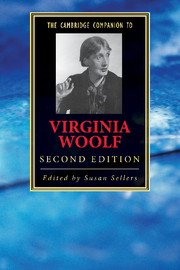Book contents
- Frontmatter
- 1 Bloomsbury
- 2 Virginia Woolf’s early novels: Finding a voice
- 3 From Mrs Dalloway to The Waves: New elegy and lyric experimentalism
- 4 The novels of the 1930s and the impact of history
- 5 Virginia Woolf’s essays
- 6 Virginia Woolf, modernism and modernity
- 7 The socio-political vision of the novels
- 8 Woolf’s feminism and feminism’s Woolf
- 9 Virginia Woolf and sexuality
- 10 Virginia Woolf, Empire and race
- 11 Virginia Woolf and visual culture
- 12 Virginia Woolf and the public sphere
- Guide to further reading
- Index
6 - Virginia Woolf, modernism and modernity
Published online by Cambridge University Press: 28 July 2010
- Frontmatter
- 1 Bloomsbury
- 2 Virginia Woolf’s early novels: Finding a voice
- 3 From Mrs Dalloway to The Waves: New elegy and lyric experimentalism
- 4 The novels of the 1930s and the impact of history
- 5 Virginia Woolf’s essays
- 6 Virginia Woolf, modernism and modernity
- 7 The socio-political vision of the novels
- 8 Woolf’s feminism and feminism’s Woolf
- 9 Virginia Woolf and sexuality
- 10 Virginia Woolf, Empire and race
- 11 Virginia Woolf and visual culture
- 12 Virginia Woolf and the public sphere
- Guide to further reading
- Index
Summary
I have an idea that I will invent a new name for my books to supplant 'novel'. A new ------- by Virginia Woolf? But what?
(D3, p. 34)On 27 June 1925, as she completed To the Lighthouse, Virginia Woolf's concerns with stylistic and formal innovation were displaced by a concern with the literary marketplace. The phrase Woolf contemplates for her latest work was apparently intended as advertising copy; a book's title page would not have referred to it as 'new'. Had she classified To the Lighthouse as an 'elegy', as the diary entry goes on to suggest, she would have given it a place in literary tradition, but she would also have given it a generic category. Her later decision to subtitle Orlando 'a biography' resulted in some bookshops failing to display it alongside other fiction (D3, p. 198), and, in the longer term, may have contributed to its exclusion from the canon of her novels. The literary marketplace valued innovation, but its emphasis on the uniqueness of each new work was opposed by a deeper tendency to view the book as a commodity, and all commodities as interchangeable. And from the perspective of the market, even uniqueness is ultimately valuable only because it makes the commodity more marketable.
The aesthetic phenomenon of modernism needs to be understood in its relation to the social and historical phenomena of modernity, and Woolf's modernism is no exception; the difficulty is that no single definition of modernity is entirely adequate. Woolf’s diary for 27 June 1925 vividly illuminates the interface between formally innovative writing and the commercial orientation of modernity. But this was by no means the first point of contact: the work, like all modernist works, was not conceived in isolation from modernity, but in dialogue with it; sometimes in reaction against modernity, sometimes drawing aspects of modernity into its form and texture. Woolf may be compared to her modernist contemporaries by virtue of this dialogue, but differentiated from them in its details and tone.
- Type
- Chapter
- Information
- The Cambridge Companion to Virginia Woolf , pp. 107 - 123Publisher: Cambridge University PressPrint publication year: 2010
- 4
- Cited by



